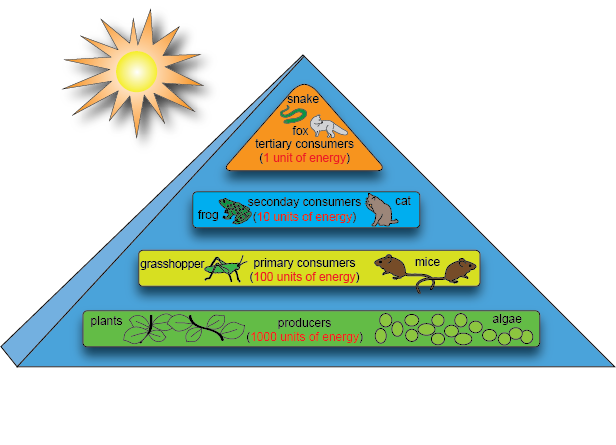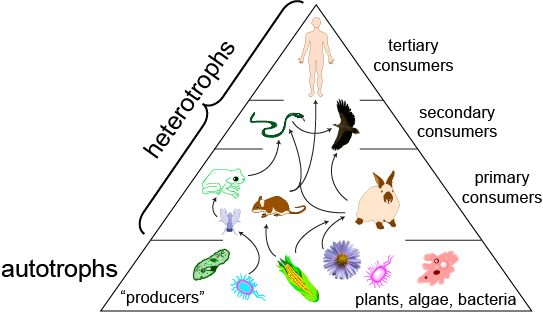energy flow in the ecosystem
Nearly all of the energy that drives ecosystems ultimately comes from the sun. Solar energy, which is an abiotic factor, by the way, enters the ecosystem through the process of photosynthesis. You can learn more than you want to know about this process in the unit on photosynthesis. Or, you could just chat with your localbotanist. Everyone has one, right? The organisms in an ecosystem that capture the sun’s electromagnetic energy and convert it into chemical energy are called producers. Not to be confused with these Producers.The name is appropriate because producers make the carbon-based molecules, usually carbohydrates, that the rest of the organisms in the ecosystem, including you, consume. Producers include all of the green plants and some bacteria andalgae. Every living thing on Earth literally owes its life to the producers. The next time you see a plant, it wouldn’t be a bad idea for you to thank it for its services…which, as you will learn in other units, go way beyond just supplying you with food.After a producer has captured the sun’s energy and used it to grow yummy plant parts, other organisms come along and greedily gobble it up. These primary consumers, as they are called, exclusively feed on producers. If these consumers are human, we call them vegetarians. Otherwise, they are known as herbivores.
Primary consumers only obtain a fraction of the total solar energy—about 10%—captured by the producers they eat. The other 90% is used by the producer for growth, reproduction, and survival, or it is lost as heat. You can probably see where this is going. Primary consumers are eaten by secondary consumers. An example would be birds that eat bugs that eat leaves. Secondary consumers are eaten bytertiary consumers. Cats that eat birds that eat bugs that eat leaves, for instance.
At each level, called a trophic level, about 90% of the energy is lost. What a shame. So, if a plant captures 1000 calories of solar energy, a bug that eats the plant will only obtain 100 calories of energy. A chicken that eats the bug will only obtain 10 calories, and a human that eats the chicken will only obtain 1 calorie of the original 1000 calories of solar energy captured by the plant. When you think about this way, it would take 100 1000-calorie plants—those would be enormo plants, by the way—to produce a single 100-calorie piece of free-range chicken. You are now recalling all of the plants you have ever forgotten to water in your life and feeling really, really terrible about it, aren’t you?
The relationships among producers, primary consumers, secondary consumers, andtertiary consumers is usually drawn as a pyramid, known as an energy pyramid, with producers at the bottom and tertiary consumers at the top. You can see from the example above why producers are at the bottom of this pyramid. It takes a lot of producers for higher-trophic-level consumers, like humans, to obtain the energy they need to grow and reproduce.
This is the answer to the great mystery as to why there are so many plants on Earth. We will even spell it out for you because it is so important to understand: there are so many plants on Earth because energy flow through ecosystems is inefficient. Only 10% of the energy in one trophic level is ever passed to the next. So, there you have it. We hope you feel fulfilled.

In addition to energy pyramid diagrams, ecosystem ecologists sometimes depict the relationship between trophic groups in a linear way, with arrows pointing from one organism to another. If there is only one producer, one primary consumer, one secondary consumer, and one tertiary consumer, this linear diagram is called a food chain. Food chains help ecologists and students visualize the interactions between organisms in an ecosystem. As always seems to be the case, it isn’t ever that simple. In fact, trophic interactions among organisms in an ecosystem are often really complex. It’s rare that an ecosystem only has one species at each trophic level. Usually, there are multiple producers that are eaten by multiple primary consumers. Some consumers eat different kinds of producers. Likewise, secondary consumers sometimes eat producers as well as primary consumers. These are known as omnivores.
These complex relationships are often depicted—if they can be figured out, that is—in a diagram called a food web. These diagrams can become messy indeed, depending on the size of the ecosystem and the number of interactions among trophic groups. If you like puzzles and biology, though, ecosystem ecology is the field for you.

Ecologists use food webs to better understand the intricate workings of the ecosystems they study. Understanding exactly who is eating whom can provide valuable information for conservation biologists as well. Such knowledge can aid in restoration efforts, species recovery projects, and preservation efforts, just to name a few instances. In any case, uncovering food webs goes a long way to understanding the first half of an ecosystem, the community.

